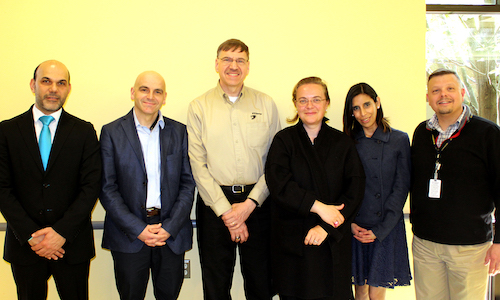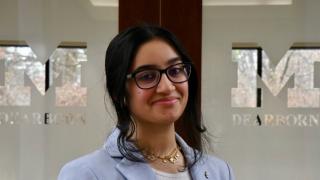Data is everywhere—and the business analytics capstone course in the Master of Science in Business Analytics program trains students how they can use it to create business solutions.
The graduate program educates professionals to use algorithms, techniques and software to uncover patterns and trends in aggregate data. And the capstone course—Decision Sciences 635, which is overseen by Operations Management Professor Charu Chandra—puts these skills to the test.
Working with DTE Energy, a group of College of Business graduate students sifted through seven years of data containing 350,000 outage occurrences. Each occurrence contained thousands of customers.
The outcome? A statistical model to better predict the impact of weather events on customer outages.
“The end result proved to be very valuable and DTE Electric is currently using this statistical model in our daily operations,” said DTE Emergency Preparedness and Response Director Lorenzo Romeri. “DTE Energy was extremely pleased with the support received by Professor Chandra’s team. “
MS-Business Analytics students in the elective capstone course work on these types of projects for organizations each semester. Students have worked with companies like Ford Motor Co., DTE Energy, Stefanini IT Solutions Inc., Henry Ford Health Systems, St. Luke’s Hospital, Gardner White Furniture and more.
“It’s structured like a consulting relationship,” said Chandra, who finds and fosters the business partnerships. “I’m there to help steer the students, but not to take their project over. I won’t be there with them once they graduate, and I want them to know how to show proven results and be successful.”
Chandra says course space is limited and depends on the number of businesses involved each semester—he keeps class groups to three or four students. He chooses students for the course based on their skill set, academic performance and drive.
At the end of the semester, teams showcase their project findings to their industry sponsors and the university community with a formal presentation and a written report.
Chandra said most companies do implement the student-proposed solutions into their business—just like how DTE Energy now uses the weather outage forecasting tool created by students Sandrine Schirmacher, Maria Fernanda Soto Alfaro and Issam Ozeir.
Ozeir, who graduated in the spring and now works as a data specialist with Citibank, said he moved to Michigan specifically to enroll in the Business Analytics program after seeing Chandra talk about the program online. Ozeir, who had an M.B.A. and worked for a company in Florida forecasting business market trends, said he knew it was the right choice for him.
“I was plugging information into models other people had created. But I wanted to create something of my own—something that would be beneficial,” he said. “You create and bring something new instead of working with something someone has made for you. That is why I like it. It challenges your mind.”
In addition to the years of data, Ozeir’s group also looked at four main variables during each outage occurrence: temperature, humidity, air pressure and wind speed.
“We have a very good lab on campus, but when we put the data into the lab’s computer, we waited 15-20 minutes for result to come back. That is the amount of data we had to work through,” he said. “And, within three months, we used that data to deliver a solution to DTE.”
Ozeir said he recommends the program and the course to anyone interested in using data to create business solutions.
“Business constantly evolves and this is what’s next. This gives you experience on what real data looks like and how to work with American corporations,” he said. “It will shape your future and sharpen your skills. And you can positively affect the lives of people. If you have an interest, do it. Don’t think twice.”


